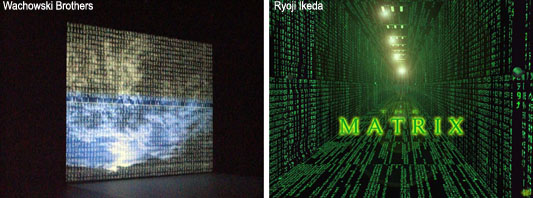

 subscribe
subscribe
Ryoji Ikeda's 'performance/installation' hybrid, shown at the Barbican on Monday night, was comprised of 2 parts, mainly exploiting sound's physical property, and its causality with human perception.
The first part of the performance was "formula [prototype-ver.2.3]", a work in progress that Ryoji first performed at Queen Elizabeth's Hall in 2000. So over the past 6 years the project has apparently been constantly evolving.
Formula consists of Ikeda's sound frequencies, which are visualised on screen through various graphics and stroboscopic lighting effects, which I believe Ikeda controlled from the back of the auditorium. But to what extent this was a performance more than installation is not clear. Perhaps Mr. Ikeda could have made a very brief introduction to clarify these points (and save being hassled by idiots like me during the interval!)
Formula begins with that sound you can make by licking you finger and running it round the edge of a wine glass. A single white line extends across the screen, occasionally flickering with any changes to the humming noise. A new sonar-like sound is then visualised at the point in which a new vertical line bisects with the horizontal. This bisection of lines and sounds is looped; beginning slowly, but gradually builds with additional layers of sounds/images progressively being added. Strobe lighting is generously used as this build up intensifies; with rapid montages of clouds which continually diffuse into reoccurring data grid structures ('The Matrix' effect). Nature is fragmented into precise mathematical data: one interpretation of beauty transformed to another almost imperceptible beauty.
Bass almost unbearably floods the room and the randomness gives way to rhythm, which I tap my foot to. The audio becomes dominant to the visuals. The strobe flashes again and a fast bass beat signals yet more matrix's of code. Static noise is created at the multiplying bisecting lines, which increase in tempo building into a deafening crescendo. This is apparently "the most beautiful ugly sound in the world" as the on screen text tells us. The climax of images which rapidly flash onto screen, replace the natural world of clouds outputting a remixed dystopian (or Phillip K Dick-ian) vision of a technological future where nature and beauty is reduced to numerical code (The Matrix effect).
Towards the end of Formula the performance rather randomly (and unnecessarily?) seems to take on a political discourse with the use of (anti-)American imagery (George Bush, the White House etc). I can't help thinking this is a cheap shot at making his work seem more political = substantial.
A new scene then quite cleverly presents more rapidly changing data, this time in the form of the front page of the New York Times, filling the screen. The newspapers template stays the same, but the content/articles rapidly switch from from one story to the next. Perhaps a year's worth of front pages are chronicled in seconds. This is typical of the way Ikeda compresses time and space into milli-seconds.
In part two of the concert, Ikeda presents 'C4I', a project that explores aesthetic potentials of data by using data itself - always changing. Warp factor 9. The tactics are to materialise the hidden constants of data of the everyday world/universe.
"C4I" at first appears again like a matrix of data, a periodic table (made up of elements symbols and their atomic structure). However this time we are taken on a more narrative journey, which is again political but this time in a more subtle and interesting way.
The 4 C's in the title are explained: command, control, communication, computer, intelligence. Perhaps these are the core 'elements' of his own work, or his interpretation of the core elements of nature.
A huge bang momentarily brings the audience out of their seats. More data is rapidly visualised. This time it’s the stock market. Numbers crawl across the screen, graphs show the beauty of the peaks and trophs of the world economy. More text on the screen tells us "the labyrinth that consists of a single straight line that is continuous and endless."
A new visualisation is created. Again the single horizontal line stretches across the screen but this time a map of the world emerges. Along the horizontal continuum (of a hyper-dense split second) there are several times, continually fluctuating. An evolving network of connections between different points onare constantly being drawn, growing so that gradually the map is filled with a mesh network of interconnecting points. This network eventually become so dense that the map underneath disappears. Ikeda seems to be playing here with the boundary between our perception and recognition.
Ikeda strives for an aesthetic of pure data. Derived from the natural world, from global systems such as economics and from research mathematics, data forms a new material for the artist's explorations. For example, Ikeda presents us with random facts: "only 1 person in 10 thinks the government respond to them", "around 3% of world's population live outside their origin of birth", "a help of the world's obese people are from developing world"; "150 countries use torture".
Ultimately Ikeda performance seems to have been met with mixed opinion by IDM/NME MA students but I enjoyed his work, the section much more so than the first.
| Attachment | Size |
|---|---|
| dataclouds_thematrix.jpg | 72.63 KB |